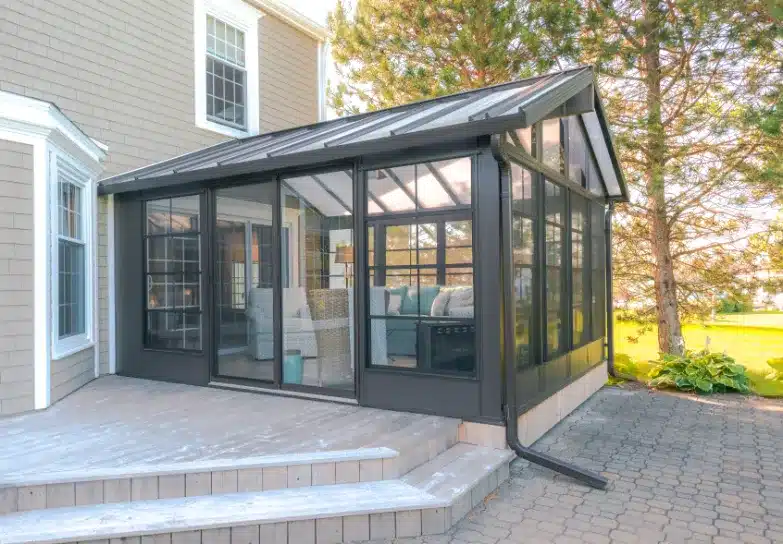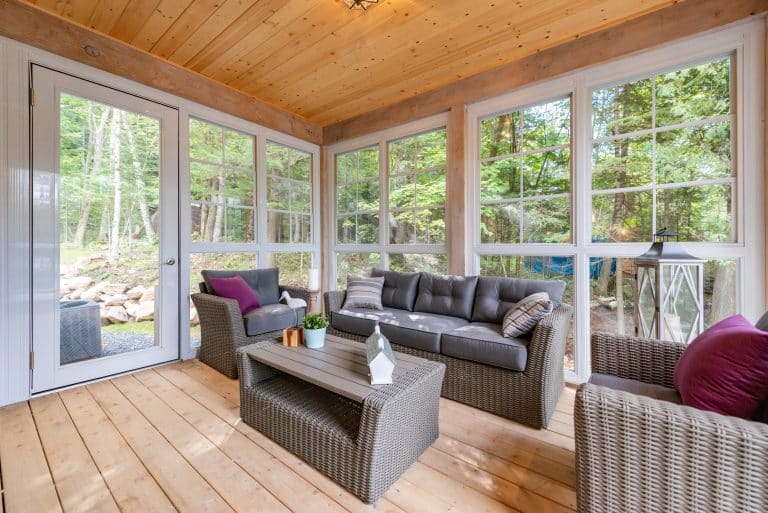Adding a sunroom to your home is an exciting opportunity to enjoy natural light, views, and comfort in a controlled environment. However, choosing the right windows is critical, especially when factoring in seasonal use. Whether you’re building a 3-season or an insulated sunroom, the window system you select will impact energy efficiency, comfort, and overall performance throughout the year.
Matching Window Systems to Seasonal Use
Your sunroom’s intended seasonal usage plays a defining role in which windows will work best. A space used during the warmer months has different performance needs than one that’s expected to be comfortable in mid-winter.

Spring to Fall (3-Season Sunrooms)
For sunrooms primarily used from spring through fall, your goal is to maximize ventilation while still protecting against rain and wind. Vinyl window systems like Sunspace WeatherMaster are ideal for 3-season sunrooms. They offer up to 75% ventilation, excellent flexibility, and are more impact-resistant than traditional glass. These windows allow you to enjoy the outdoors without exposure to bugs or harsh weather.
Year-Round Comfort (Insulated Sunrooms)
If you plan to use your sunroom all year, thermal insulation becomes a top priority. In this case, double- or triple-pane glass windows with low-E coatings and argon gas fills are the preferred choice. These systems reduce heat loss during the winter and block UV rays during summer, keeping the space comfortable and energy-efficient regardless of the season.
Features to Prioritize for Each Season
Windows in a sunroom are more than just a view: they must adapt to seasonal conditions. Each feature contributes to how well your sunroom performs.
UV and Heat Control in Summer
In warmer seasons, large windows can let in excess heat and harmful UV rays. Tinted glass or vinyl panels with solar reflective coatings help reduce glare and solar gain, keeping your space cooler and more comfortable. They also protect your furniture and flooring from fading over time.
Draft Reduction and Insulation for Winter
In colder regions, choosing windows with advanced insulation properties is essential. Look for thermal breaks in the frame, double- or triple-pane glass, and energy-efficient spacers. These elements minimize drafts and retain indoor warmth, helping reduce heating costs during winter.
Adjustable Ventilation for Transitional Seasons
Spring and fall bring mild temperatures that call for flexible ventilation. Windows that slide open vertically or horizontally, such as those in the WeatherMaster system, offer control over airflow. This allows you to enjoy fresh air without compromising on comfort.

Comparing Common Window Types
Understanding the differences between popular window types will help you make an informed decision based on your specific goals and location.
WeatherMaster Vinyl vs. Traditional Glass
Vinyl window systems like WeatherMaster provide more durability, impact resistance, and flexibility than traditional glass especially in 3-season spaces. While they don’t insulate like thermal glass, they perform well in moderate climates and are less prone to damage. Glass, particularly when thermally insulated, is the better choice for insulated rooms, offering superior energy performance.
Sliding Windows vs. Fixed Panels
Sliding windows provide functional airflow and ease of cleaning, making them popular in sunrooms where cross-ventilation is desired. Fixed panels, while visually sleek, limit airflow and are typically used to create expansive views. The ideal configuration often includes a mix of both, depending on room design.
Horizontal vs. Vertical Orientation
Vertical sliding panels (such as those in WeatherMaster systems) offer more control over the amount of ventilation and are generally easier to operate. Horizontal sliders can be beneficial in wider window openings. Your choice depends on the framing layout and how much airflow you want to allow at different heights.
Factors That Influence the Right Choice
While each glass type has benefits, your specific needs and home layout will guide the best selection for your project.
Orientation and Sun Exposure of Your Sunroom
If your sunroom faces south or west, it will receive the most direct sunlight making tinted glass a wise choice to reduce heat and glare. North-facing rooms may benefit more from clear glass to make the most of limited daylight. East-facing rooms strike a balance and could work well with any glass type, depending on privacy concerns.
Intended Use of the Space
How you plan to use your sunroom matters. A lounge area, reading nook, or yoga studio may call for soft diffused light and added privacy: ideal for frosted glass. A family room or dining area might benefit more from clear glass for openness or tinted glass for comfort during the day.
Glass Your Way: Exploring the Flexible Options Offered by Sunspace
Sunspace designs its products with flexibility, durability, and style in mind, offering solutions tailored to your sunroom’s function and seasonal use. WeatherMaster windows come with integrated tint options (clear, smoke grey, bronze, or dark grey) to control heat and UV exposure without sacrificing views. Sliding systems, available in vertical or horizontal formats, can be customized with fixed or operable panels to enhance airflow and layout. Featuring impact-resistant ViewFlex vinyl, these panels are both lightweight and easy to maintain. Sunspace dealers, like Sunspace Central Ohio, provide expert guidance to help you choose the right combination for your needs, ensuring compatibility and long-term value.

Sunspace Central Ohio: ATrusted Partner in Your Region
If you’re located in the Ohio area, Sunspace Central Ohio is one of the most trusted and experienced Sunspace dealers available. Their team offers expert advice, installation support, and product customization tailored to your region’s climate. From choosing the right tint to selecting the best window configuration for your lifestyle, their knowledge and service make the process seamless and rewarding.
With a clear understanding of seasonal needs, glass and vinyl options, and regional considerations, you’re better equipped to make a confident decision about your sunroom windows. Let your space reflect both your personal style and the demands of your environment without compromise.


